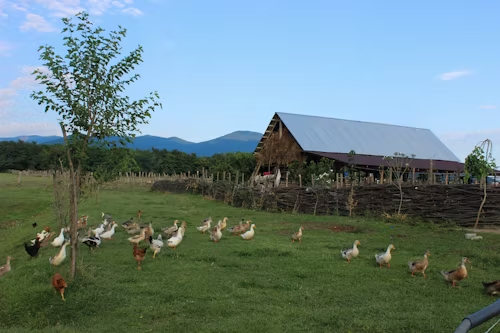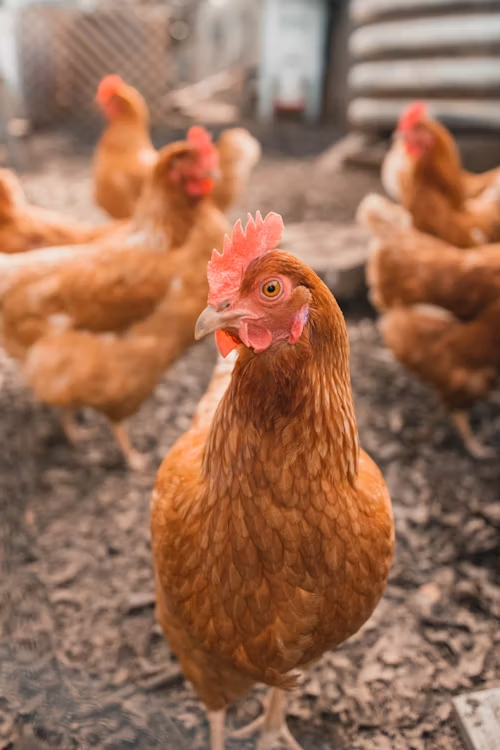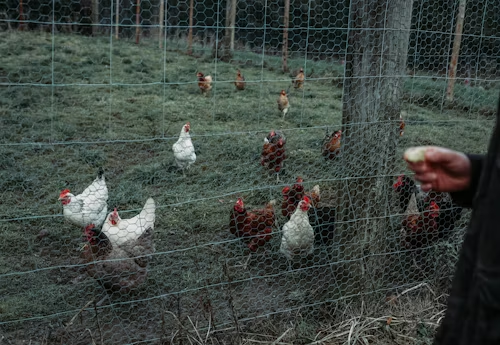Keep your flock healthy, comfortable, and productive throughout the colder months with these essential winter care strategies.
As temperatures drop and daylight hours shorten, your backyard chickens need some extra attention to thrive during winter. While chickens are remarkably hardy birds, cold weather presents unique challenges that require preparation and vigilance from their caretakers. This comprehensive guide will help you ensure your flock stays healthy, comfortable, and even productive during the coldest months of the year.
Understanding Cold Weather and Chickens
Before diving into specific care strategies, it's helpful to understand how chickens naturally respond to cold weather:
- Built-in insulation: Chickens have natural insulation in their feathers. Their downy undercoat traps warm air close to their bodies, providing effective protection against cold.
- Cold-hardy breeds: Some breeds, particularly those with larger bodies, small combs, and dense feathering, are naturally more cold-tolerant. Breeds like Orpingtons, Wyandottes, Plymouth Rocks, and Brahmas typically handle winter well.
- Metabolic adjustments: Chickens naturally increase their metabolism in colder weather to generate more body heat, which is why they often eat more during winter months.

Winterizing the Coop
The chicken coop is your flock's primary protection against winter's harshness. Here's how to create a winter-ready shelter:
1. Draft Prevention vs. Ventilation
One of the most critical aspects of winter coop management is finding the right balance between eliminating drafts and maintaining proper ventilation.
Finding the Right Balance
- Eliminate drafts at chicken level - cold air blowing directly on roosting birds can lead to frostbite and illness
- Maintain ventilation above bird level - this allows moisture and ammonia from droppings to escape while preventing respiratory issues
- Consider installing adjustable vents near the roof that can be partially closed during extreme weather
2. Insulation Considerations
While not strictly necessary in moderate climates, insulation can be beneficial in areas with prolonged freezing temperatures:
- Insulate walls and ceiling with appropriate materials (foam board, fiberglass batts with protective covering, or reflective bubble insulation)
- Ensure chickens cannot peck at insulation materials
- Consider a thicker layer of bedding on the coop floor for ground insulation
- Remember: an overcrowded but well-ventilated coop is often naturally warmer from the birds' body heat
3. The Deep Litter Method
This age-old technique creates natural warmth through decomposition while reducing coop cleaning in winter:
- Start with a 4-6 inch layer of bedding (pine shavings work well)
- Rather than removing soiled bedding, add fresh material on top regularly
- Turn the bedding occasionally to encourage decomposition
- The decomposition process generates slight warmth
- Clean out the entire deep litter in spring
Important: The deep litter method requires proper ventilation to prevent ammonia buildup. If you detect a strong ammonia smell, increase ventilation immediately and consider a partial litter change.
4. Roosting Area Optimization
Roosting is where chickens spend their longest stretches of cold winter nights:
- Position roosts away from windows and in the least drafty area of the coop
- Use 2×4 lumber with the 4-inch side facing up so chickens can cover their feet with their bodies while roosting
- Place all roosts at the same height to prevent fighting for higher positions (or slightly stagger them with adequate spacing)
- Allow 8-10 inches of roosting space per bird

Preventing Frostbite
Frostbite is one of winter's most common chicken health concerns, particularly affecting combs, wattles, and feet:
Protection Strategies
- Comb protection: Apply a thin layer of petroleum jelly to large combs and wattles during extremely cold weather
- Breed selection: Birds with smaller combs (like Wyandottes with rose combs) are naturally less susceptible to frostbite
- Humidity control: Maintaining proper ventilation reduces moisture that can increase frostbite risk
- Dry bedding: Keep bedding dry, especially in heavily trafficked areas
Signs of frostbite: White, pale, or grayish areas on combs/wattles; blackened areas in severe cases. If you notice these symptoms, gradually warm the affected area with slightly warm (not hot) water and keep the bird in a moderately warmed area until recovered. Apply antibacterial ointment to prevent infection.
Winter Feeding Adjustments
Proper nutrition becomes even more critical during winter when chickens use more energy to stay warm:
1. Increased Caloric Needs
- Chickens may require 1.5× their normal feed amount during the coldest periods
- Feed higher protein content (18-20%) during extreme cold
- Provide feed before roosting time to fuel nighttime warmth generation
2. Scratch Grains and Corn
Strategic feeding of scratch grains can help with winter warmth:
- Offer corn and scratch grains in the late afternoon/evening
- The digestion process generates body heat during the night
- Scatter small amounts in bedding to encourage scratching activity
- Limit to 10-15% of their diet to maintain balanced nutrition
3. Warm Treats
Occasional warm treats can provide comfort during exceptionally cold days:
Winter Warming Oatmeal Recipe
- 2 cups regular rolled oats
- 4 cups hot water (warm, not boiling)
- 1/2 cup mixed frozen berries, chopped vegetables, or mealworms
- 1 tablespoon poultry-safe herbs (oregano, thyme, etc.)
Mix ingredients and serve warm (not hot). Offer as an occasional treat, not a dietary staple.
Water: The Critical Resource
Access to unfrozen water is perhaps the most essential and challenging aspect of winter chicken care:
Preventing and Managing Frozen Water
- Heated waterers: Electric heated waterers or bases offer the most reliable solution
- Regular replacement: Without heated options, replace frozen water 2-3 times daily
- Ping pong balls: Placing a few ping pong balls in waterers can help prevent freezing as they move with any breeze
- Slightly warmed water: Starting with warmed water in the morning extends unfrozen time
- Multiple stations: Provide several water stations to ensure access if one freezes
Never use antifreeze additives, salt, or chemicals to prevent water freezing. These can be toxic to chickens.

Winter Light and Egg Production
Decreasing daylight hours naturally reduce egg production. How you manage this depends on your chicken-keeping philosophy:
Options for Managing Winter Production
Natural Production Cycle
Approach: Allow chickens to follow natural rhythms with reduced or paused laying during winter
Benefits: Allows hens to rest and rebuild calcium reserves; generally healthier for the birds long-term
Management: Maintain regular care without supplemental light; expect few to no eggs during shortest days
Supplemental Lighting
Approach: Provide artificial lighting to maintain 14-16 hours of light daily
Implementation: Use a timer to provide light in morning hours (not evening, as chickens need decreasing light to navigate to roosts)
Equipment: A simple 40-60 watt bulb or LED equivalent is sufficient for most coops
Considerations: May shorten a hen's productive lifespan; requires consistent implementation
Winter Run Management
Outdoor access remains important for chicken health even in winter:
Creating Cold-Weather Outdoor Spaces
- Windbreaks: Position straw bales, temporary fencing with tarp, or evergreen branches along run fencing to block prevailing winds
- Snow management: Clear a section of the run after heavy snows; some chickens enjoy exploring snow in brief periods
- Covered areas: Extend roof over part of the run to create a snow-free zone
- Dust bathing: Provide a covered container with dry dirt/sand/wood ash mixture for winter dust bathing
- Entertainment: Hang cabbage or other vegetables on strings to provide activity and prevent boredom

Should You Heat Your Coop?
Perhaps the most debated topic in winter chicken keeping:
Arguments For Heating
- Can prevent frostbite in extreme climates
- May maintain egg production
- Provides comfort during exceptional cold snaps
- Necessary for non-cold-hardy breeds
Arguments Against Heating
- Prevents chickens from naturally adapting to cold
- Creates dependency that becomes dangerous during power outages
- Increased fire hazard
- Can cause harmful temperature fluctuations
Safer Heating Options
If you decide heating is necessary in your climate, consider these safer options:
- Flat panel heaters designed specifically for coops
- Ceramic heat emitters with protective covers
- Microwavable heating pads designed for pet use
- Deep litter method for natural heat generation
NEVER use heat lamps in chicken coops. They are a significant fire hazard and the primary cause of coop fires. If you must provide heat, use safer alternatives listed above.
Winter Chicken Health Watch
Cold weather can mask or exacerbate health issues. Be especially vigilant for:
- Respiratory issues: Cold conditions can worsen existing respiratory diseases; watch for bubbles around eyes/nostrils, wheezing, or coughing
- Vitamin deficiencies: Limited sunlight can reduce vitamin D synthesis; consider poultry vitamin supplements
- Dehydration: Chickens may drink less in cold weather; watch for signs like lethargy or concentrated droppings
- Weight loss: Regularly handle birds to check body condition under dense winter feathering
Emergency Preparedness
Winter storms and power outages require advance planning:
Winter Emergency Checklist
- Store at least 2 weeks of extra feed
- Have backup water containers ready
- Keep emergency heat options available if you use electric heating
- Prepare extra bedding materials
- Have a generator or battery backup for essential systems
- Keep snow removal tools accessible
- Have contingency plan for extreme emergencies (temporary housing options)
Monthly Winter Care Checklist
November: Preparation Month
- Seal coop drafts while ensuring ventilation
- Apply weatherproofing as needed
- Set up deep litter method if using
- Test and prepare any heating systems
- Stock up on winter supplies
December: Adjustment Month
- Monitor flock for cold tolerance
- Increase feed quantities as temperatures drop
- Begin evening corn treats if appropriate
- Add extra bedding as needed
- Implement lighting program if desired
January: Deep Winter Month
- Check for and treat any frostbite
- Monitor water systems daily
- Provide additional enrichment to prevent boredom
- Keep paths to coop clear of snow and ice
- Check coop for moisture issues
February: Late Winter Month
- Begin preparing for spring transitions
- Continue cold weather protocols while watching for warming trends
- Start reducing supplemental light gradually if used
- Monitor for early spring pests as temperatures fluctuate
- Plan spring coop cleaning
Regional Considerations
Winter chicken care varies significantly by region:
Northern/Extremely Cold Regions
- Insulation becomes more critical
- Focus on cold-hardy breeds
- Consider safe supplemental heat during extreme cold
- Have backup systems for water and potential power outages
Moderate Winter Regions
- Prepare for occasional cold snaps rather than constant cold
- Focus on windbreaks and rain protection
- Adjust management with changing conditions
Mild Winter Regions
- Focus on rain protection and muddy run management
- Watch for unusual cold spells that birds aren't acclimated to
- Be prepared for greater parasite activity during warm spells
Conclusion: Working With Chicken Nature
The most successful winter chicken keeping approaches work with the birds' natural adaptations rather than against them. Chickens have remarkable cold tolerance when properly supported with appropriate shelter, nutrition, and care.
Remember that different breeds and individual birds will have varying cold tolerance. Observe your specific flock closely and adjust your management accordingly. With proper preparation and vigilance, your flock can not only survive but thrive through the winter months.




Comments (3)
Jennifer P.
October 19, 2023This is my first winter with chickens and I was so worried about them! Thank you for the clear explanation about heating. I was planning to use a heat lamp but now I'll look into the safer panel heaters instead.
David M.
October 21, 2023I've been using the deep litter method for three winters now in Minnesota, and it works amazingly well. My coop stays around 10-15 degrees warmer than outside temperature just from the decomposition and chicken body heat. Highly recommend!
Susan T.
October 23, 2023Question: I live in the Pacific Northwest where it's more wet than cold in winter. Any specific recommendations for dealing with constant dampness rather than extreme cold?
Thomas Wilson
October 23, 2023Great question, Susan! In damp climates, focus on excellent ventilation and moisture control. Consider extending roof overhangs to keep rain away from the coop, use moisture-absorbing bedding like pine shavings, and change it more frequently. Sand in the run area can also help with drainage. I'll put together a specific article on damp climate management soon!
Leave a Comment